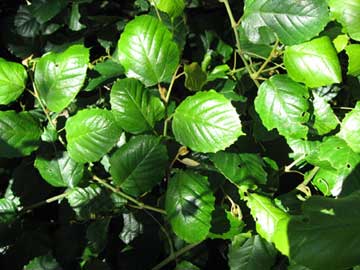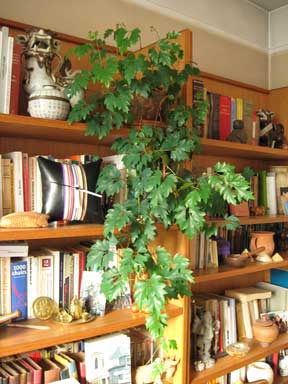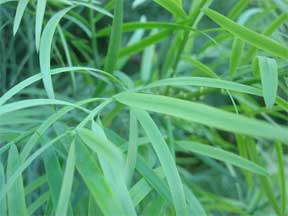Indoor house plants and foliage plants should be decorative, since adding beauty to the indoor scene is their primary purpose. Equally important, however, is their durability, and the ease with which they may be grown.
Often we are apt to be so “taken” with a plant’s appearance that we buy it without giving a thought to the care it may require. After we’ve had such a plant at home for a few days, we realize, too late, that we have a real problem child!
When selecting foliage plants for your home, do give some thought to their cultural needs, and if possible select material whose requirements match or closely approximate the existing indoor conditions. It is much easier, and much more satisfactory, to fit plants to your home than it is to change your home to suit the plants.
The average home is usually quite arid, especially in winter, and the temperature is high. In addition, light is dim, except in the area close to windows, or where artificial lighting is used.

These conditions are not ideal for maximum plant growth, but there are many excellent foliage and house plants which will do well under them. Listed below are some old favorites and some new introductions which I have found worthwhile as specimen plants and in combination with other plants. (If you are familiar with all of them, you rate as a real connoisseur of choice foliage plants!)
Vines as Houseplants
First, I must admit that I’m partial to the use of vines in indoors. They can be developed as individual specimens, and trained to fill any spot selected for them, or they can be used to add a graceful touch to blend a group of dissimilar plants into a pleasing whole.
Of course, you already know grape-ivy (Cissus rhombifolia), and undoubtedly have admired its deep green tri-parted leaves which are glossy above and somewhat furry beneath. The “grape” part of its common name is derived not from the leaf form but from the tendrils by which the plant climbs. It is equally charming grown as a trailer, however, and branches freely, assuming a pleasingly bushy appearance with age.
Another Cissus, known as kangaroo vine, is Cissus antarctica, even more durable than grape-ivy, and a plant that does extremely well even under the most trying conditions. I have seen it flourishing in doorway planters, where it was exposed to cold drafts and was constantly brushed against by passing traffic, and I have seen it used in very dim corners as well as in sunny windows; it seems able to survive no matter what culture it is given.

This variety of Cissus has entire, toothed or notched leaves, and may climb by means of its tendrils although it is more inclined toward a shrubby, prostrate growth. Coarser in appearance than grape-ivy, it is better suited to bold plantings which are composed of medium-to-large leaved plants.
Both these vines like a fairly rich, turfy soil, and enjoy adequate light and water. They will endure neglect, but naturally better specimens will result from better care. Both are easily propagated from cuttings which root readily in plain water, or in any conventional rooting medium. An old-time favorite vine now enjoying a recurrence of popularity is creeping fig (Ficus repens, sometimes Ficus pumila).
Close relatives of this plant, the so-called rubber plants of great-grandmother’s day, have long been noted for their willingness to grow under the most trying conditions, and this same characteristic endears creeping fig to indoor gardeners who are familiar with it.
This plant has small, closely set, pointed oval leaves, light green when new, deep green in maturity. It does best when allowed to creep and climb porous surfaces, like a bark slab and outdoors a concrete wall; grown this way, it branches freely, crossing and recrossing itself l until it may become necessary to thin old growth drastically in order to prevent self-strangulation.
The plant may flower and set fruit, although this possibility with a pot grown plant is slight. Creeping fig does best in well drained soil, subdued light, and normal watering. Propagate by cuttings.
I have saved for last the description of my own favorite, Mexican flame vine (Senecio auriculatissimus). In all my years of growing indoor, I have seldom found a plant to equal this in sheer willingness to grow. In fact, it grows so rampantly when conditions are to its liking that few nurseries carry it… they don’t want their benches overrun by its rapid growth.
Mexican flame vine has toothed, pointed oval, glossy leaves, green when grown in subdued light and with a reddish tinge when exposed to direct sunlight. The leaves reflex sharply against the long petioles, enabling the plant to climb by grasping thin supports. The plant, a rapid grower as previously noted, branches freely and seldom gets a bare, leggy look.
It is not easy to bring into flower when grown indoors, but may produce daisy-like terminal blossoms in brilliant orange. Flame vine will tolerate almost any soil or exposure, and it is not particular about temperature but it does require an abundance of water at all times. Cuttings will root within a few days in plain water.
Shrubby Types
Shrubby plants are the real backbone of the indoor garden. You may already be familiar with Japanese yew (Podocarpus macrophylla) , whose long narrow leaves grow in whorls upon the branches. A semi-variegated appearance results from the pale yellow-green color of new growth contrasting with the very deep green of mature foliage.

A most versatile and durable plant, this resinous evergreen may be allowed to grow in its normal bushy form or it may be carefully pruned to simulate a dwarf tree.
If you want a “short-cut” dwarf tree with leaves that look like leaves, instead of like pine needles, Podocarpus nagi is the plant for you. Leaves are a deep, glossy green, oval with long pointed tips, and are set regularly along the branches. Although not a “new” plant, it hasn’t received the same popularity as has been given Japanese yew, so it is not as well known, and has yet to acquire a common name.
Both these plants need a mixture of well drained potting soil, strong light without direct sun, and ample water. They may be propagated by seed or cuttings.
Fatshedera, sometimes called tree-ivy, is purportedly a cross between an aralia and an ivy. Some growers claim this just couldn’t happen and while I’m not about to stick my neck out, horticulturally, by saying such a hybrid could or could not be, I am certainly willing to recommend fatshedera as an excellent house plant, no matter what its origin.
Characterized by great glossy leaves in classic ivy shape, fatshedera is a shrub very similar to the ivy leaved aralia. Large, well-branched plants, each leaf carefully polished, make exceptionally handsome specimen plants, while small plants are ideal for table decoration. To induce bushiness, plants should be “pruned” when only a few inches high.
Give fatshedera a loose, rich soil, subdued light and ample water. Propagate by cuttings. For a little find indoors this year, try something old and something new from the group of plants described above. Flowering plants sometimes present a challenge to even the most experienced plant professional, but anyone can grow foliage plants!
Contributed by Katherine B. Walker, Michigan
